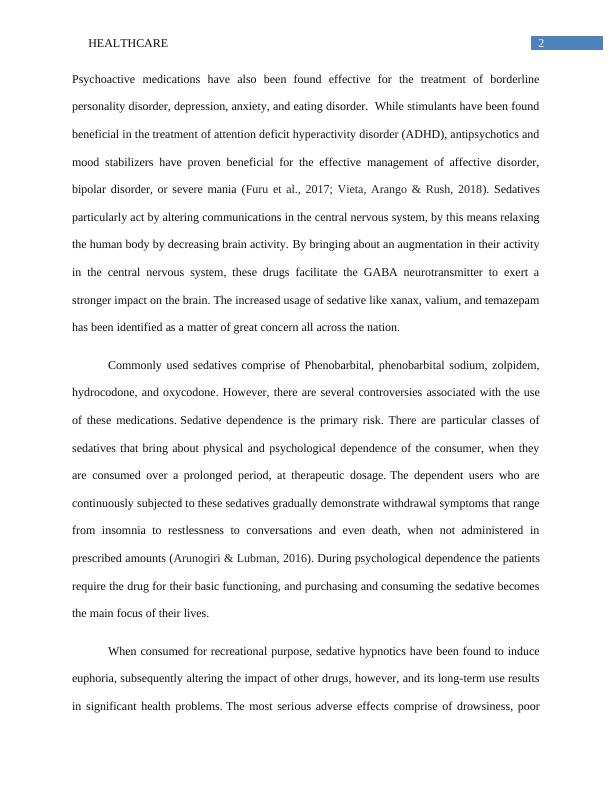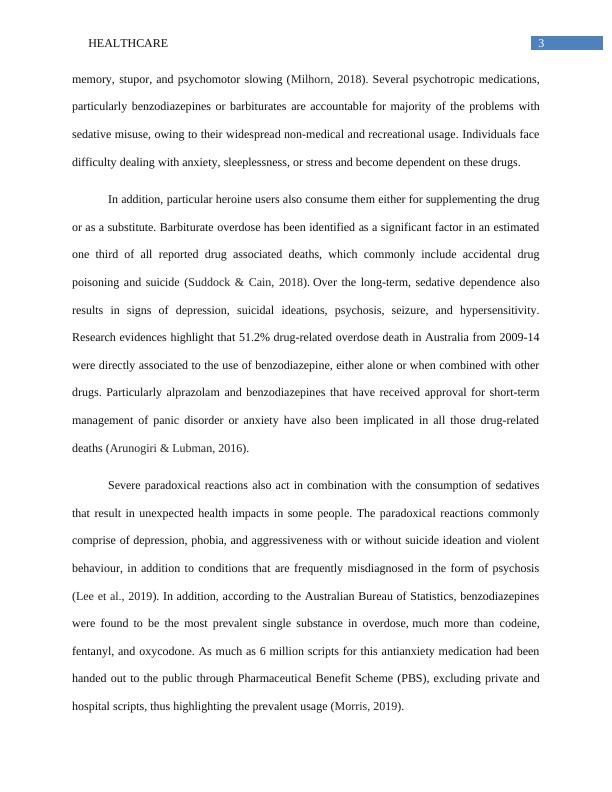journal of the European College
12 Pages3287 Words17 Views
Added on 2022-08-24
journal of the European College
Added on 2022-08-24
ShareRelated Documents
Running head: HEALTHCARE
NRSG263 Principles of Nursing: Mental Health
Name of the Student
Name of the University
Author Note
NRSG263 Principles of Nursing: Mental Health
Name of the Student
Name of the University
Author Note

1HEALTHCARE
Introduction- Also referred to as psychopharmaceutical drug or psychoactive
drug, psychotropic medications are chemical substances that are responsible for triggering
alterations in the function of the brain, subsequently leading to variations in mood, perception,
cognition, behaviour or consciousness. These medications might be used recreationally or
medically, with the aim of enhancing performance or altering the consciousness, of a particular
individual (Hagen & Tushingham, 2019). They are often used in the form of entheogens for
spiritual, shamanic, or ritual purpose. Particular categories of psychotropic medications that have
therapeutic values comprise of analgesics and aesthetics, antiparkinsonian drugs, and
anticonvulsant drugs, in addition to medications that are used for the treatment of
neuropsychiatric disorders like antipsychotics, stimulants, anxiolytics and antidepressants
(Aixalá et al., 2019).
Sedative medication acts in the form of a central nervous system depressant, and directly
interacts with the activity of the brain, thereby leading to its deceleration. There are different
types of sedative drugs available; however, the majority of them create an impact on the gamma
aminobutyric neurotransmitter (GABA), which is primarily responsible for initiating
communication between the neurons (Brohan & Goudra, 2017). This essay will critically discuss
the controversy associated with uses of psychotropic medications, and the challenges that
registered nurses have to encounter while administering them.
Controversy associated with the use of psychotropic medication- General anaesthetics
are a type of psychotropic medications that are used for providing relief from pain, by reducing
consciousness, thereby allowing the affected person to be subjected to medical procedure like
operations, without any emotional trauma or physical pain. The subjective experience of pain is
predominantly controlled by endogenous opioid peptides (Patrick, Cooper & Davis, 2017).
Introduction- Also referred to as psychopharmaceutical drug or psychoactive
drug, psychotropic medications are chemical substances that are responsible for triggering
alterations in the function of the brain, subsequently leading to variations in mood, perception,
cognition, behaviour or consciousness. These medications might be used recreationally or
medically, with the aim of enhancing performance or altering the consciousness, of a particular
individual (Hagen & Tushingham, 2019). They are often used in the form of entheogens for
spiritual, shamanic, or ritual purpose. Particular categories of psychotropic medications that have
therapeutic values comprise of analgesics and aesthetics, antiparkinsonian drugs, and
anticonvulsant drugs, in addition to medications that are used for the treatment of
neuropsychiatric disorders like antipsychotics, stimulants, anxiolytics and antidepressants
(Aixalá et al., 2019).
Sedative medication acts in the form of a central nervous system depressant, and directly
interacts with the activity of the brain, thereby leading to its deceleration. There are different
types of sedative drugs available; however, the majority of them create an impact on the gamma
aminobutyric neurotransmitter (GABA), which is primarily responsible for initiating
communication between the neurons (Brohan & Goudra, 2017). This essay will critically discuss
the controversy associated with uses of psychotropic medications, and the challenges that
registered nurses have to encounter while administering them.
Controversy associated with the use of psychotropic medication- General anaesthetics
are a type of psychotropic medications that are used for providing relief from pain, by reducing
consciousness, thereby allowing the affected person to be subjected to medical procedure like
operations, without any emotional trauma or physical pain. The subjective experience of pain is
predominantly controlled by endogenous opioid peptides (Patrick, Cooper & Davis, 2017).

2HEALTHCARE
Psychoactive medications have also been found effective for the treatment of borderline
personality disorder, depression, anxiety, and eating disorder. While stimulants have been found
beneficial in the treatment of attention deficit hyperactivity disorder (ADHD), antipsychotics and
mood stabilizers have proven beneficial for the effective management of affective disorder,
bipolar disorder, or severe mania (Furu et al., 2017; Vieta, Arango & Rush, 2018). Sedatives
particularly act by altering communications in the central nervous system, by this means relaxing
the human body by decreasing brain activity. By bringing about an augmentation in their activity
in the central nervous system, these drugs facilitate the GABA neurotransmitter to exert a
stronger impact on the brain. The increased usage of sedative like xanax, valium, and temazepam
has been identified as a matter of great concern all across the nation.
Commonly used sedatives comprise of Phenobarbital, phenobarbital sodium, zolpidem,
hydrocodone, and oxycodone. However, there are several controversies associated with the use
of these medications. Sedative dependence is the primary risk. There are particular classes of
sedatives that bring about physical and psychological dependence of the consumer, when they
are consumed over a prolonged period, at therapeutic dosage. The dependent users who are
continuously subjected to these sedatives gradually demonstrate withdrawal symptoms that range
from insomnia to restlessness to conversations and even death, when not administered in
prescribed amounts (Arunogiri & Lubman, 2016). During psychological dependence the patients
require the drug for their basic functioning, and purchasing and consuming the sedative becomes
the main focus of their lives.
When consumed for recreational purpose, sedative hypnotics have been found to induce
euphoria, subsequently altering the impact of other drugs, however, and its long-term use results
in significant health problems. The most serious adverse effects comprise of drowsiness, poor
Psychoactive medications have also been found effective for the treatment of borderline
personality disorder, depression, anxiety, and eating disorder. While stimulants have been found
beneficial in the treatment of attention deficit hyperactivity disorder (ADHD), antipsychotics and
mood stabilizers have proven beneficial for the effective management of affective disorder,
bipolar disorder, or severe mania (Furu et al., 2017; Vieta, Arango & Rush, 2018). Sedatives
particularly act by altering communications in the central nervous system, by this means relaxing
the human body by decreasing brain activity. By bringing about an augmentation in their activity
in the central nervous system, these drugs facilitate the GABA neurotransmitter to exert a
stronger impact on the brain. The increased usage of sedative like xanax, valium, and temazepam
has been identified as a matter of great concern all across the nation.
Commonly used sedatives comprise of Phenobarbital, phenobarbital sodium, zolpidem,
hydrocodone, and oxycodone. However, there are several controversies associated with the use
of these medications. Sedative dependence is the primary risk. There are particular classes of
sedatives that bring about physical and psychological dependence of the consumer, when they
are consumed over a prolonged period, at therapeutic dosage. The dependent users who are
continuously subjected to these sedatives gradually demonstrate withdrawal symptoms that range
from insomnia to restlessness to conversations and even death, when not administered in
prescribed amounts (Arunogiri & Lubman, 2016). During psychological dependence the patients
require the drug for their basic functioning, and purchasing and consuming the sedative becomes
the main focus of their lives.
When consumed for recreational purpose, sedative hypnotics have been found to induce
euphoria, subsequently altering the impact of other drugs, however, and its long-term use results
in significant health problems. The most serious adverse effects comprise of drowsiness, poor

3HEALTHCARE
memory, stupor, and psychomotor slowing (Milhorn, 2018). Several psychotropic medications,
particularly benzodiazepines or barbiturates are accountable for majority of the problems with
sedative misuse, owing to their widespread non-medical and recreational usage. Individuals face
difficulty dealing with anxiety, sleeplessness, or stress and become dependent on these drugs.
In addition, particular heroine users also consume them either for supplementing the drug
or as a substitute. Barbiturate overdose has been identified as a significant factor in an estimated
one third of all reported drug associated deaths, which commonly include accidental drug
poisoning and suicide (Suddock & Cain, 2018). Over the long-term, sedative dependence also
results in signs of depression, suicidal ideations, psychosis, seizure, and hypersensitivity.
Research evidences highlight that 51.2% drug-related overdose death in Australia from 2009-14
were directly associated to the use of benzodiazepine, either alone or when combined with other
drugs. Particularly alprazolam and benzodiazepines that have received approval for short-term
management of panic disorder or anxiety have also been implicated in all those drug-related
deaths (Arunogiri & Lubman, 2016).
Severe paradoxical reactions also act in combination with the consumption of sedatives
that result in unexpected health impacts in some people. The paradoxical reactions commonly
comprise of depression, phobia, and aggressiveness with or without suicide ideation and violent
behaviour, in addition to conditions that are frequently misdiagnosed in the form of psychosis
(Lee et al., 2019). In addition, according to the Australian Bureau of Statistics, benzodiazepines
were found to be the most prevalent single substance in overdose, much more than codeine,
fentanyl, and oxycodone. As much as 6 million scripts for this antianxiety medication had been
handed out to the public through Pharmaceutical Benefit Scheme (PBS), excluding private and
hospital scripts, thus highlighting the prevalent usage (Morris, 2019).
memory, stupor, and psychomotor slowing (Milhorn, 2018). Several psychotropic medications,
particularly benzodiazepines or barbiturates are accountable for majority of the problems with
sedative misuse, owing to their widespread non-medical and recreational usage. Individuals face
difficulty dealing with anxiety, sleeplessness, or stress and become dependent on these drugs.
In addition, particular heroine users also consume them either for supplementing the drug
or as a substitute. Barbiturate overdose has been identified as a significant factor in an estimated
one third of all reported drug associated deaths, which commonly include accidental drug
poisoning and suicide (Suddock & Cain, 2018). Over the long-term, sedative dependence also
results in signs of depression, suicidal ideations, psychosis, seizure, and hypersensitivity.
Research evidences highlight that 51.2% drug-related overdose death in Australia from 2009-14
were directly associated to the use of benzodiazepine, either alone or when combined with other
drugs. Particularly alprazolam and benzodiazepines that have received approval for short-term
management of panic disorder or anxiety have also been implicated in all those drug-related
deaths (Arunogiri & Lubman, 2016).
Severe paradoxical reactions also act in combination with the consumption of sedatives
that result in unexpected health impacts in some people. The paradoxical reactions commonly
comprise of depression, phobia, and aggressiveness with or without suicide ideation and violent
behaviour, in addition to conditions that are frequently misdiagnosed in the form of psychosis
(Lee et al., 2019). In addition, according to the Australian Bureau of Statistics, benzodiazepines
were found to be the most prevalent single substance in overdose, much more than codeine,
fentanyl, and oxycodone. As much as 6 million scripts for this antianxiety medication had been
handed out to the public through Pharmaceutical Benefit Scheme (PBS), excluding private and
hospital scripts, thus highlighting the prevalent usage (Morris, 2019).

End of preview
Want to access all the pages? Upload your documents or become a member.
Related Documents
NRSG263 Principles of Nursing: Mental Healthlg...
|12
|3242
|18
MH2 Mental Health Document Analysislg...
|13
|3726
|34
Free Assignment on Psychotropic Medicationslg...
|11
|2974
|24
Psychotropic Drug | Mental Health Nursinglg...
|12
|3304
|17
Assignment on Psychotropic Drugslg...
|8
|3131
|67
Assessment of Psychotropic Medications in Healthcarelg...
|12
|1062
|389
